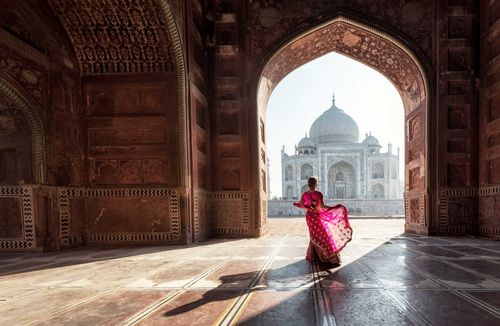Eating and the right-hand rule
The biggest minefield of potential faux pas has to do with eating. This is usually done with the fingers, and requires practice to get absolutely right. Rule one is: eat with your right hand only. In India, as right across Asia, the left hand is for wiping your bottom, cleaning your feet and other unsavoury functions (you also put on and take off your shoes with your left hand), while the right hand is for eating, shaking hands and so on.
Quite how rigid individuals are about this tends to vary, with brahmins (who, at the top of the hierarchical ladder, are one of the two “right-handed castes”) and southerners likely to be the strictest. While you can hold a cup or utensil in your left hand, and you can get away with using it to help tear your chapatti, you should not eat, pass food or wipe your mouth with your left hand.
This rule extends beyond food. In general, do not pass anything to anyone with your left hand, or point at anyone with it either; and Indians won’t be impressed if you put it in your mouth. In general, you should accept things given to you with your right hand – though using both hands is a sign of respect.
The other rule to beware of when eating or drinking is that your lips should not touch other people’s food – jhutha, or sullied food, is strictly taboo. Don’t, for example, take a bite out of a chapatti and pass it on. When drinking out of a cup or bottle to be shared with others, don’t let it touch your lips, but rather pour it directly into your mouth. This custom also protects you from things like hepatitis. It is customary to wash your hands before and after eating.
Temples and religion
Religion is taken very seriously in India; it’s important always to show due respect to religious buildings, shrines, images, and people at prayer. When entering a temple or mosque, remove your shoes and leave them at the door (socks are acceptable and protect your feet from burning-hot stone ground). Some temples – Jain ones in particular – do not allow you to enter wearing or carrying leather articles, and forbid entry to menstruating women. In the southern state of Kerala, most Hindu temples are closed to non-Hindus, but those that aren’t require men to remove their shirts before entering (women must wear long dresses or skirts).
In a mosque, non-Muslims would not normally be allowed in at prayer time and women are sometimes not let in at all. In a Hindu temple, you are often not allowed into the inner sanctum; and at a Buddhist stupa or monument, you should always walk round clockwise (ie, with the stupa on your right). Hindus are very superstitious about taking photographs of images of deities and inside temples; if in doubt, desist.
Funeral processions are private affairs, and should be left in peace. In Hindu funerals, the body is normally carried to the cremation site within hours of death by white-shrouded relatives (white is the colour of mourning). The eldest son is expected to shave his head and wear white following the death of a parent. At Varanasi and other places, you may see cremations; such occasions should be treated with respect and photographs should not be taken.
Dress
Indian people are very conservative about dress. Women are expected to dress modestly, with legs and shoulders covered. Trousers are acceptable, but shorts and short skirts are offensive to many. Men should always wear a shirt in public, and avoid skimpy shorts away from beach areas. These rules are particularly important in temples and mosques. Cover your head with a cap or cloth when entering a dargah (Sufi shrine) or Sikh gurudwara; women in particular are also required to cover their limbs. Men are similarly expected to dress appropriately with their legs and head covered. Caps are usually available on loan, often free, for visitors, and sometimes cloth is available to cover up your arms and legs.
Never mind sky-clad Jains or Naga Sadhus, nudity is not acceptable in India. Topless bathing is not uncommon in Goa (though it is in theory prohibited), but you can be sure the locals don’t like it.
In general, Indians find it hard to understand why rich Westerners should wander round in ragged clothes or imitate the lowest ranks of Indian society, who would love to have something more decent to wear. Staying well groomed and dressing “respectably” vastly improves the impression you make on local people and reduces sexual harassment for women, too.
Other possible gaffes
Kissing and embracing are regarded in India as part of sex: do not do them in public. In more conservative areas (ie outside Westernized parts of big cities or tourist enclaves), it is still rare for couples to hold hands, though Indian men can sometimes be seen holding hands as a sign of “brotherliness”. Be aware of your feet. When entering a private home, you should normally remove your shoes (follow your host’s example); when sitting, avoid pointing the soles of your feet at anyone. Accidental contact with one’s foot is always followed by an apology.
Indian English can be very formal and even ceremonious. Indian people may well call you “sir” or “madam”, even “good lady” or “kind sir”. At the same time, you should be aware that your English may seem rude to them. In particular, swearing is taken rather seriously, and casual use of the f-word is likely to shock.
Meeting people
Westerners have an ambiguous status in Indian eyes. In one way, you represent the rich sahib, whose culture dominates the world, and the old colonial mentality has not completely disappeared. On the other hand, as a non-Hindu, you are an outcaste, your presence in theory polluting to an orthodox or high-caste Hindu, while to members of all religions, your morals and your standards of spiritual and physical cleanliness are suspect.
As a traveller, you will constantly come across people who want to strike up a conversation. English not being their first language, they may not be familiar with the conventional ways of doing this, and thus their opening line may seem abrupt if at the same time very formal. “Excuse me gentleman, what is your native place?” is a typical one. It is also the first in a series of questions that Indian men seem sometimes to have learnt from a single book in order to ask Western tourists. Some of the questions may baffle at first (“What is your qualification?” “Are you in service?”), some may be queries about the ways of the West or the purpose of your trip, but mostly they will be about your family and your job.
You may find it odd or even intrusive that complete strangers should want to know that sort of thing, but these subjects are considered polite conversation between strangers in India, and help people place one another in terms of social position. Your family, job, even income, are not considered “personal” subjects, and it is completely normal to ask people about them. Asking the same questions back will not be taken amiss – far from it. Being curious does not have the “nosey” stigma in India that it has in the West.
Things that Indian people, especially if they are older or more traditional, are likely to find strange about you are lack of religion (you could adopt one), travelling alone, leaving your family to come to India, being an unmarried couple (letting people think you are married can make life easier), and travelling second class or staying in cheap hotels when, as a tourist, you are relatively rich. You will probably end up having to explain the same things many times to many different people; on the other hand, you can ask questions too, so you could take it as an opportunity to ask things you want to know about India. English-speaking Indians and members of the large and growing middle class in particular are usually extremely well informed and well educated.














